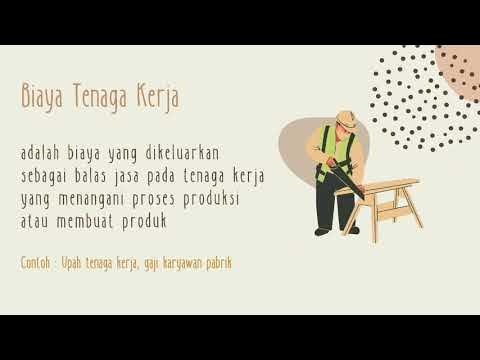Akuntansi biaya tenaga kerja
Summary
TLDRThis video script provides an in-depth exploration of labor cost accounting, focusing on how labor costs are allocated to goods in the production process. It explains key concepts such as direct labor costs, wages, and salaries, highlighting the differences between them. The script also covers methods for calculating labor costs, the importance of timekeeping, and the use of computerized systems for tracking working hours. Additionally, it addresses challenges like idle time, overtime, shift premiums, and the handling of bonuses. The content further explores factory overhead costs, with practical examples of journal entries and payment processes.
Takeaways
- 😀 Labor costs are essential for companies as they reflect the payments made to workers in the production process.
- 😀 Wages are directly linked to production, while salaries are categorized as factory overhead costs.
- 😀 The method for calculating labor costs can be based on working hours or production units, which affects how costs are allocated.
- 😀 Accurate work time recording is essential for determining labor costs, with options for manual or computerized systems.
- 😀 Labor costs can be calculated using an hourly rate, per unit produced, or incentive plans that reward extra performance.
- 😀 Labor costs are allocated to goods in process or factory overhead costs after the initial calculation of wages.
- 😀 Special adjustments are made for employee payments, including deductions for taxes and insurance when salaries are paid.
- 😀 Idle time (when workers are not productive) is treated as factory overhead costs and not part of direct labor.
- 😀 Shift premiums and bonuses are considered factory overhead costs and not part of direct labor costs.
- 😀 Reworking damaged products requires additional labor, which is also added to factory overhead costs, including overtime or idle time.
- 😀 Salary costs are debited and wage debt is credited, reflecting an increase in the company’s debt until payment is made.
Q & A
What is the difference between wages and salaries in labor cost accounting?
-Wages are typically associated with hourly work or production unit-based payments and are considered direct labor costs. Salaries, on the other hand, are fixed payments to employees and are generally classified under factory overhead costs.
How are wages calculated in a production environment?
-Wages can be calculated based on an hourly rate, the number of units produced, or through incentive plans that offer additional pay for exceeding performance standards.
What is the significance of allocating direct labor costs to products?
-Allocating direct labor costs to products is essential for accurate product costing. This helps in determining the total cost of production, which is crucial for pricing, profitability analysis, and financial reporting.
How does a company allocate labor costs to factory overhead?
-Labor costs are allocated to factory overhead by recording wages and salary payments in the appropriate accounts. Idle time, shift premiums, and overtime are all considered and allocated to factory overhead, ensuring accurate tracking of all associated costs.
What are the journal entries for labor costs in a manufacturing process?
-The journal entries typically involve debiting goods in process and factory overhead accounts, while crediting the salary and wage costs. This reflects the allocation of labor costs to products being produced.
What is the role of idle time in labor cost allocation?
-Idle time, or unproductive hours, is an important factor to consider. When workers are not actively producing, such as waiting for raw materials, the associated costs are allocated to factory overhead rather than to direct labor.
How does the company handle shift premiums in labor cost accounting?
-Shift premiums, which are additional payments for working night shifts or other non-standard hours, are classified as factory overhead costs. These premiums are included in the overall labor cost calculation to ensure accurate costing of production.
What happens to labor costs when products are damaged or need rework?
-When products are damaged and require rework, the additional labor costs are treated as factory overhead. This ensures that all costs related to fixing the issues are incorporated into the final cost of production.
Why are performance bonuses included in factory overhead?
-Performance bonuses are considered part of the total labor cost and are allocated to factory overhead because they are not directly tied to individual units of production but rather to overall performance or company goals.
What impact does calculating labor costs have on product pricing?
-Accurate labor cost calculation helps ensure that the full cost of production is reflected in the pricing of the product. This allows the company to maintain profitability while ensuring that all direct and indirect labor-related expenses are accounted for.
Outlines

This section is available to paid users only. Please upgrade to access this part.
Upgrade NowMindmap

This section is available to paid users only. Please upgrade to access this part.
Upgrade NowKeywords

This section is available to paid users only. Please upgrade to access this part.
Upgrade NowHighlights

This section is available to paid users only. Please upgrade to access this part.
Upgrade NowTranscripts

This section is available to paid users only. Please upgrade to access this part.
Upgrade NowBrowse More Related Video

Cost Terms and Concepts in Cost & Management Accounting Part 2, Manufacturing Costs, Mike Werner

Perhitungan Biaya Produksi - Materi Prakarya dan Kewirausahaan Kelas X KD 3.4/4.4

Menghitung Harga Pokok Produksi - Part 1

METODE HARGA POKOK PESANAN 2 : JURNAL DAN KARTU PESANAN

Biaya Produksi | Biaya Non Produksi | Menganalisis Biaya Prototype Produk Barang/Jasa

KONSEP BIAYA DAN KLASIFIKASI BIAYA (BAGIAN 1)
5.0 / 5 (0 votes)